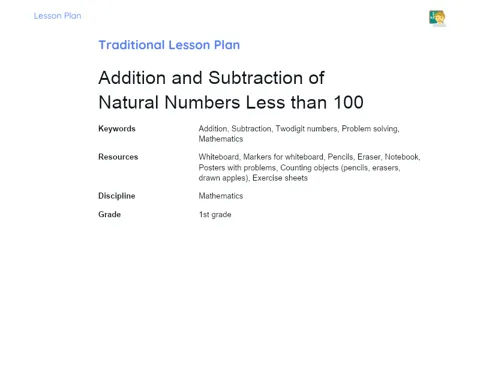Lesson Plan | Traditional Methodology | Quadrilateral: Rhombus
| Keywords | Rhombus, Quadrilateral, Properties of the rhombus, Internal angles, Diagonals, Area of the rhombus, Perimeter of the rhombus, Geometry, High School, Mathematics |
| Required Materials | Whiteboard, Markers, Ruler, Calculator, Sheets of paper, Pencil, Eraser, Projector (optional), Presentation slides (optional) |
Objectives
Duration: (10 - 15 minutes)
The purpose of this stage is to provide a clear and concise overview of the learning objectives of the lesson. This helps students focus on key points and understand what is expected of them by the end of the lesson. It also guides the teacher in structuring the lesson to ensure that all important topics are addressed effectively.
Main Objectives
1. Understand what a rhombus is.
2. Calculate the measures of sides and angles in a rhombus.
3. Solve problems involving rhombuses, identifying that a rhombus is a quadrilateral with all sides equal.
Introduction
Duration: (15 - 20 minutes)
The purpose of this stage is to contextualize the theme of the lesson, sparking student interest by showing how the rhombus is relevant and present in everyday situations. By providing a rich initial context and interesting curiosities, the teacher engages the students and prepares them for a deeper understanding of the content that will be addressed.
Context
To start the lesson on rhombuses, begin by explaining that a rhombus is a special type of quadrilateral. A quadrilateral is a flat geometric figure with four sides. Among the types of quadrilaterals, we find the rhombus, which has some specific properties. A rhombus is characterized by having all sides of equal length and its opposite angles are equal. Additionally, the diagonals of a rhombus intersect at right angles and bisect each other, meaning they divide themselves equally. These properties make the rhombus an interesting and useful geometric figure in various everyday applications, such as in engineering, architecture, and design.
Curiosities
Did you know that rhombuses are often used in design patterns and architecture? For example, many floors and tiles feature rhombus patterns to create an aesthetic and symmetrical appearance. Additionally, kites, which are very popular toys, often have the shape of a rhombus, taking advantage of their geometric properties to ensure stability in flight.
Development
Duration: (40 - 45 minutes)
The purpose of this stage is to deepen students' understanding of rhombuses by addressing their properties and associated calculations. By presenting specific topics and practical problems, the teacher facilitates detailed comprehension and application of concepts, preparing students to effectively solve questions related to rhombuses.
Covered Topics
1. Definition and Properties of the Rhombus: Explain that a rhombus is a quadrilateral with all sides equal and opposite angles equal. Detail that the diagonals intersect at right angles and bisect each other, dividing themselves equally. 2. Calculation of Internal and External Angles: Present the formula for calculating internal angles (adding 360° and dividing by the number of angles). Explain that opposite angles are equal and that the sum of the internal angles of a quadrilateral is always 360°. 3. Calculation of the Area of the Rhombus: Teach the formula for the area of the rhombus (Area = (Long diagonal x Short diagonal) / 2). Show practical examples of how to apply the formula to calculate the area. 4. Perimeter of the Rhombus: Explain how to calculate the perimeter of a rhombus (Perimeter = 4 x side). Present practical examples to reinforce the concept. 5. Diagonals of the Rhombus: Detail how the diagonals divide the rhombus into four equal right triangles. Explain that these diagonals are perpendicular and bisect each other.
Classroom Questions
1. Calculate the area of a rhombus whose diagonals measure 10 cm and 8 cm. 2. A rhombus has sides of 5 cm. What is the perimeter of the rhombus? 3. If a rhombus has an internal angle of 60°, what are the values of the other internal angles?
Questions Discussion
Duration: (25 - 30 minutes)
The purpose of this stage is to consolidate students' knowledge through detailed discussion of the resolved questions. By reviewing explanations and engaging students with reflective questions, the teacher ensures that the concepts have been comprehended solidly and allows students to clarify any doubts. This stage also promotes active student participation, facilitating a deeper and more meaningful learning experience.
Discussion
-
Question 1: Calculate the area of a rhombus whose diagonals measure 10 cm and 8 cm.
-
To solve this question, apply the formula for the area of a rhombus: Area = (Long diagonal x Short diagonal) / 2.
-
Substituting the values, we have: Area = (10 cm x 8 cm) / 2 = 80 cm² / 2 = 40 cm².
-
Question 2: A rhombus has sides of 5 cm. What is the perimeter of the rhombus?
-
To calculate the perimeter, we use the formula: Perimeter = 4 x side.
-
Substituting the value of the side, we have: Perimeter = 4 x 5 cm = 20 cm.
-
Question 3: If a rhombus has an internal angle of 60°, what are the values of the other internal angles?
-
We know that the opposite angles of a rhombus are equal and that the sum of the internal angles of any quadrilateral is 360°.
-
Since the rhombus has two pairs of opposite angles that are equal, we have two angles of 60° and two angles that sum to 300° (360° - 60° - 60°).
-
Dividing 300° by the two remaining angles, we have: 300° / 2 = 150°.
-
Therefore, the internal angles of the rhombus are 60°, 150°, 60°, and 150°.
Student Engagement
1. How did you apply the formula for the area of the rhombus in the first question? 2. What difficulties did you encounter while calculating the perimeter of the rhombus? 3. Can you think of other everyday situations where the properties of the diagonals of the rhombus would be useful? 4. How does the sum of the internal angles of a quadrilateral help determine the angles of a rhombus? 5. Can you identify the angles of a rhombus in objects around you, such as tiles or kites?
Conclusion
Duration: (10 - 15 minutes)
The purpose of this stage is to recap the main points of the lesson, reinforcing students' understanding and ensuring they have a clear and consolidated view of the content covered. It also aims to connect theory to practice and highlight the importance of the topic, promoting more significant learning.
Summary
- A rhombus is a quadrilateral with all sides equal and opposite angles equal.
- The diagonals of a rhombus intersect at right angles and bisect each other.
- The sum of the internal angles of a rhombus is always 360°.
- The formula for the area of a rhombus is: Area = (Long diagonal x Short diagonal) / 2.
- The perimeter of a rhombus is calculated using the formula: Perimeter = 4 x side.
The lesson connected theory with practice by explaining each property and formula of the rhombus and then applying these concepts in practical examples. This allowed students to see how calculations and properties are used to solve real problems involving rhombuses.
The topic presented is important for everyday life because rhombuses are often found in design patterns, architecture, and even in toys such as kites. Understanding their properties can help students solve practical problems and appreciate the application of geometry in various fields.



